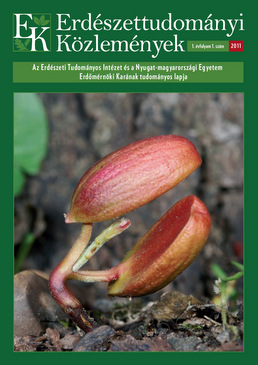Riparian forest impact onto streamflow recession curve and its meaning
Péter Kalicz, Zoltán Gribovszki & Géza Király
Correspondence
Correspondence: Kalicz Péter
Postal address: H-9400 Sopron, Bajcsy-Zsilinszky u. 4.
e-mail: kaliczp[at]emk.nyme.hu
Abstract
In rainless periods groundwater feeds streamflow and on the falling limb of the streamflow hydrograph a recession curve can be detected. Lot of important information can be deduced from the recession curve. One of the simplest model of a catchment water resources recession is an exponential curve fitting to the falling limb of a hydrograph as a linear reservoir model.
From steepness of streamflow recession curves catchment scale hydraulic conductivity value can be calculated. Riparian vegetation (especially preatophyte riparian forest) use generally large amount of groundwater resources for transpiration, so it has a significant effect on the steepness of the recession curve in the growing season. Therefore only dormant season (transpiration-free) recession curves can be used for estimation of hydraulic parameters. The apparent residence time (inverse of the recession curve steepness) changes parallel with the transpiration intensity during the growing season.
Groundwater evapotranspiration of the riparian zone can be estimated from the steepness of recession curves in the growing season using the combination of the linear storage model and the catchment groundwater balance.
The groundwater evapotranspiration estimation method was tested in streamflow time series of the two neighboring subcathment (Farkas Valley and the Vadkan Valley) of the fully forest covered Hidegvíz Valley experimental catchment, located in the Sopron Hills (Hungary). On the basis of recession curves 5.8 and 6.2 mm/day growing season mean groundwater evapotranspiration can be calculated between 2000 and 2005 for the dry periods. The method gives fairly high but reasonable groundwater evapotranspiration compared to other evapotranspiration estimations in case of similar riparian forests.
Keywords: groundwater evapotranspiration, riparian forest, recession curve, linear storage model
Open Acces
For non-commercial purposes, let others distribute and copy the article, and include in a collective work, as long as they cite the author(s) and the journal, and provided they do not alter or modify the article.
Cite this article as:
Kalicz, P., Gribovszki, Z. & Király, G. (2011): Riparian forest impact onto streamflow recession curve and its meaning. Bulletin of Forestry Science, 1(1): 45-57. (in Hungarian)
Volume 1, Issue 1
Pages: 45-57
First published:
1 September 2011
Related content
4
More articles
by this authors
4
Related content in the Bulletin of Forestry Science*
More articles by this authors in the Bulletin of Forestry Science
* Automatically generated recommendations based on the occurrence of keywords given by authors in the titles and abstracts of other articles. For more detailed search please use the manual search.
